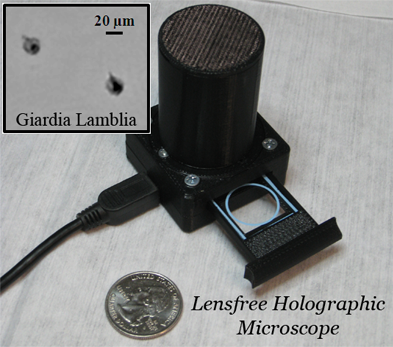Detection of Waterborne Parasites using Field-portable and Cost-effective Lensfree Microscopy published in Lab on a Chip (2010)
By O. Mudanyali , C. Oztoprak , D. Tseng ,

Protection of human health and well-being through water quality management is an important goal for both the developed and thedeveloping parts of the world. In the meantime, insufficient disinfection techniques still fail to eliminate pathogenic contaminants infreshwater as well as recreational water resources. Therefore, there is a significant need for screening of water quality to prevent waterborne outbreaks and incidents of water-related diseases. Toward this end, here we investigate the use of a field-portable and cost-effective lensfreeholographic microscope to image and detect pathogenic protozoan parasites such as Giardia Lamblia and Cryptosporidium Parvum at low concentration levels. This compact lensless microscope (O. Mudanyali et al., Lab Chip, 2010, 10, 1417–1428), weighing 46 grams, achieves a numerical aperture of 0.1–0.2 over an imaging field of view that is more than an order of magnitude larger than a typical 10Xobjective lens, and therefore may provide an important high-throughput analysis tool for combating waterborne diseases especially in resource limitedsettings.